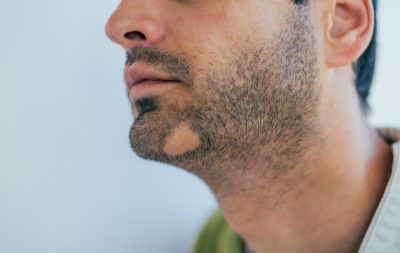Hair loss can manifest itself in several ways and from different causes. One  such example is alopecia areata, an autoimmune disease that develops when the body begins to attack its own hair follicles. While a common sign of alopecia areata is round or oval patches on the scalp, the hair loss can occur anywhere on the body. Some people experience fingernail or toenail changes marked by dents, ridges, brittleness. However, most who experience this type of hair loss tend to be in good health otherwise.
such example is alopecia areata, an autoimmune disease that develops when the body begins to attack its own hair follicles. While a common sign of alopecia areata is round or oval patches on the scalp, the hair loss can occur anywhere on the body. Some people experience fingernail or toenail changes marked by dents, ridges, brittleness. However, most who experience this type of hair loss tend to be in good health otherwise.
Read on as we discuss some of the more frequent questions about alopecia areata.
At what age does alopecia areata begin? While this condition can begin at any age, many develop it in childhood or during their teen years, with most cases manifesting themselves by age 30. Cycles can be unpredictable and can last for years. Some see hair regrowth within 12 months with the potential that it won’t fall out again.
Is it hereditary? If a parent or close relative suffers from alopecia areata, a child is at greater risk of developing the condition.
What are the types of alopecia areata? The main types are:
- Alopecia areata – Patches of hair loss on the scalp, beard area, eyelashes, eyebrows, armpits, inside the nose and ears, or anywhere else on the body.
- Alopecia totalis – Complete hair loss on the scalp.
- Alopecia universalis – A rare condition where a person loses all bodily hair.
What are common signs and symptoms? As we mentioned, alopecia areata can occur anywhere on the body. Wherever it occurs, it usually reveals itself as a round or oval patch without any redness, rash, or scarring. The affected skin looks as if someone shaved the area. Men who have alopecia areata may develop a bald patch on their beard. Some individuals develop a strip of bald skin on the scalp while others experience widespread hair loss. Complete loss of eyebrows, eyelashes, or both are also common.
What causes alopecia areata? Cells in a person’s immune system mistakenly surround and attack hair follicles, causing the attached hair to fall out. The good news is that the attack rarely destroys hair follicles, meaning hair can regrow on its own. However, alopecia areata cannot be cured. People who experience regrowth may lose more hair later and continue to experience cycles of hair loss and regrowth. If your hair does not regrow on its own, consult your health care provider for medical treatment options.
Of course, you do have an option other than waiting for alopecia areata to correct itself. And that’s to contact the hair transplant specialists at DiStefano Hair Restoration Center for a free consultation during which we’ll assess your condition and recommend a solution sure to restore your confidence and any loss of self-esteem. Contact us today – we’d love to hear from you.


